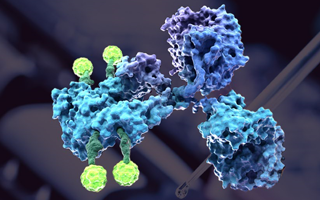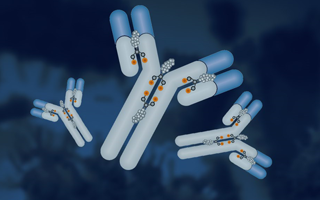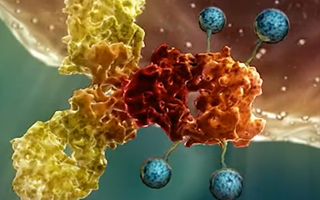Lysosome Positioning Intrabody Development Service
Based on experimental design and optimization with sophisticated validation, Creative Biolabs is able to screen natural lysosome residing motifs and develop the first-rate lysosome positioning Intrabody for our global customers. Moreover, various specific modifications also are applicable to our Super™ intrabody development platform.
Lysosome Positioning
The lysosome is a membrane-bound spherical organelle with a size from 0.1 µm to 1.2 µm and exists in nearly all animal cells. It possesses more than 60 soluble enzymes in the luminal matrix and over 120 membrane proteins, including glycosidases, proteases (such as cathepsins), lipases (such as ACP2), nucleases, phosphatases, and sulfatases. Basically, these lysosomal proteins are synthesized in the rough endoplasmic reticulum (RER) and imported from the Golgi apparatus in a small vesicle. Subsequently, the lysosomal enzyme-filled vesicle leaves the Golgi apparatus and properly fuses with a larger acidic vesicle or a late endosome to form mature lysosome with an approximate lumen pH 4.5-5.0 comparing to the slightly basic cytosol pH 7.2. As the most prominent signature of the lysosome, the steady acidic lumen environment is maintained by proton pumps (vacuolar H+-ATPases) and chloride ion channels (C1C-7 Cl-/H+ antiporters) for optimal enzymatic activities of hydrolysis.
Physiologically, lysosome aims to break down virtually all kinds of biomolecules like peptides, nucleic acids, carbohydrate, and lipids, even fuse with other phagosomes to digesting large structures and cellular debris for autophagy or break down virus particles or bacteria in phagocytosis of macrophages. Other than degradation of polymers, lysosome also involves in secretion, plasma membrane repair, cellular signaling, and energy metabolism.
Unfortunately, there are more than 30 mutations of lysosomal proteins leading to different human genetic disease (lysosomal storage diseases, LSD) with the rate of incidence over 1 in 5,000 live births, which is usually resulting from an accumulation of specific substrates, macromolecules, or monomeric compounds inside the endosomal-autophagic-lysosomal system unable to break down. Subsequent abnormal signaling pathways, calcium homeostasis, lipid biosynthesis and degradation, and intracellular trafficking cause pathogenetic disorders in the brain, viscera, bone, and cartilage. For instance, the most common LSD is Gaucher’s disease with a deficiency of the glucocerebrosidase, which leads to accumulation of fatty acid glucosylceramide.
Lysosome targeting
The soluble and transmembrane lysosomal proteins are targeted to lysosomes mainly in two ways:
I. Mannose 6-phosphate (M6P) dependent lysosomal targeting
The majority of lysosomal soluble acid hydrolases are M6P modified via an N-acetylglucosamine-1-phosphotransferase and N-acetylglucosamine-1-phosphodiester α N-acetylglucosaminidase in the Golgi apparatus, which is recognized by M6P-specific receptors (MPR) in the late Golgi complex to ensure transport to the endosomal/lysosomal system. The other M6P dependent sorting is mediated via alternative receptors such as lysosomal integral membrane protein LIMP-2 or sortilin.
II. Peptide signal dependent lysosomal targeting
The lysosomal proteins adopt two categories of peptide signals in the cytosolic tail for lysosomal targeting, which is dileucine-based motifs and tyrosine-based motif.
 Fig. 1 Intrabody targeting lysosomal.
Fig. 1 Intrabody targeting lysosomal.
Other Anchoring Modification Options provided by Creative Biolabs
Including the lysosome, Creative Biolabs can also develop specific positioning antibody for a variety of destination, which including but not limited to:
| Extracellular Space | Extracellular Plasma Membrane | Intracellular Plasma Membrane | Cytoplasm |
| Nucleus | Endoplasmic Reticulum | Golgi Apparatus | Mitochondria |
| Chloroplast | Lysosome | Peroxisome | Vacuoles |
Scientists of Creative Biolabs are greatly pleased to assist your valuable research with our novel lysosome positioning intrabody development platform. Please do not hesitate to inquire us for detailed information.
All of our antibody products and services can only be used for preclinical research studies. Do not use them on humans.
Related Services:
- Extracellular Space Positioning Antibody Development
- Extracellular Plasma Membrane Positioning Antibody Development
- Intracellular Plasma Membrane-Anchored Intrabody Development
- Cytoplasm Positioning Intrabody Development
- Nucleus Positioning Intrabody Development
- Endoplasmic Reticulum Positioning Intrabody Development
- Golgi Apparatus Positioning Intrabody Development
- Mitochondria Positioning Intrabody Development
- Chloroplast Positioning Intrabody Development
- Peroxisome Positioning Intrabody Development
- Vacuole Positioning Intrabody Development

Welcome! For price inquiries, please feel free to contact us through the form on the left side. We will get back to you as soon as possible.
Contact us
USA
Tel:
Fax:
Email:
UK
Tel:
Email:
Germany
Tel:
Email:







